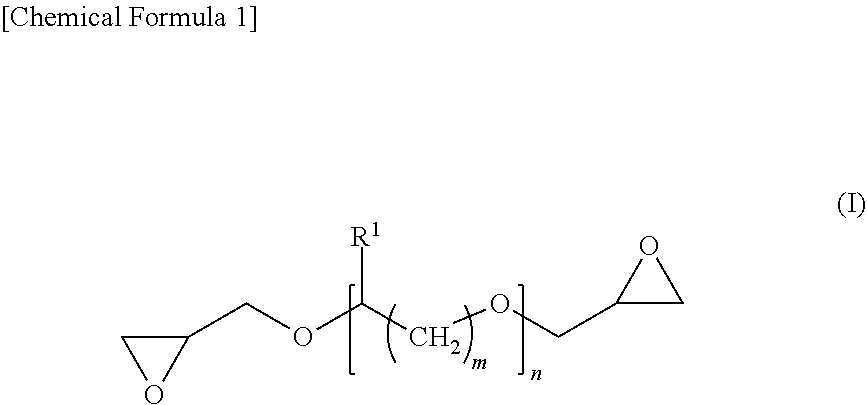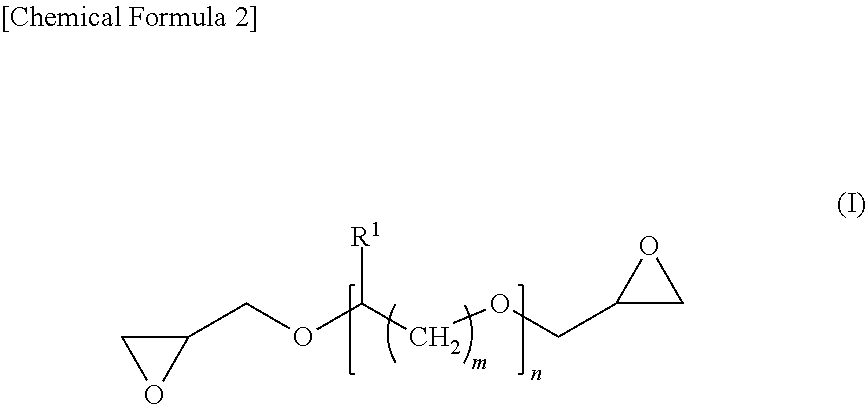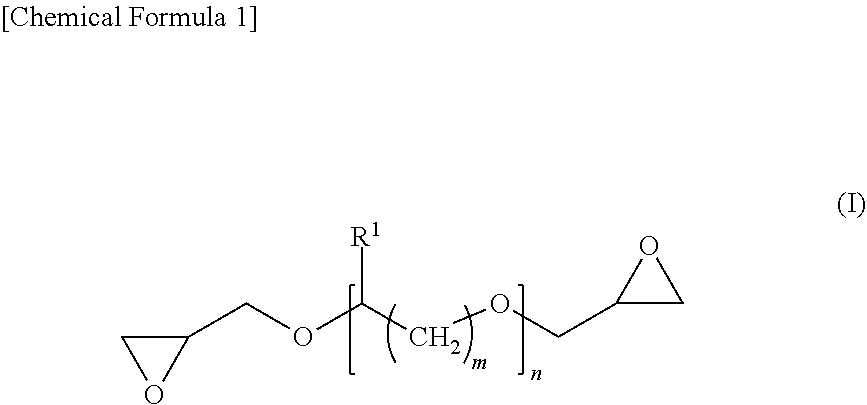Epoxy resin composition, intermediate substrate, and fiber-reinforced composite material
a technology of epoxy resin and composite material, applied in the field of epoxy resin composition, intermediate substrate, fiber-reinforced composite material, can solve the problems of insufficient mechanical strength and heat resistance of fiber-reinforced composite material, reduced elastic modulus and heat resistance of cured epoxy resin, and limited amount of particles to be added, so as to achieve high deformation and maintain heat resistance
- Summary
- Abstract
- Description
- Claims
- Application Information
AI Technical Summary
Benefits of technology
Problems solved by technology
Method used
Image
Examples
example 1
[0162]An epoxy resin composition was prepared according to the using 2 parts by mass of “DENACOL” (registered trademark) EX-911, 90 parts by mass of “jER” (registered trademark) 828, and 8 parts by mass of “jER” (registered trademark) 1001 as epoxy resins, 15 parts by mass of “Hypro” (registered trademark) 1300X8 as a terminal carboxy-modified acrylic rubber, 7.3 parts by mass of DICY7T as dicyandiamide, and 2.5 parts by mass of DCMU99 as an aromatic urea compound.
[0163]For this epoxy resin composition, the tensile properties were obtained according to the . The epoxy resin composition exhibited high deformability with a tensile elastic modulus of 2.9 GPa, a tensile strength of 65 MPa, and a tensile elongation at break of 7.5%. The fracture toughness value was evaluated according to the . The composition showed an excellent fracture toughness of 2.0 MPa·m0.5. The heat resistance was evaluated according to the . The composition showed a good glass transition temperature of 136° C.
[0...
examples 2 to 19
[0166]Epoxy resin compositions and cured resins were produced in the same manner as in Example 1 except that the composition of resin was changed as shown in Tables 1 to 3.
[0167]As a result of evaluating the tensile properties, the fracture toughness value, and the heat resistance of each epoxy resin composition of the examples, good physical properties were obtained at all levels. The viscosity of each epoxy resin composition of the examples at 25° C. was measured. The results were 10 to 25 Pa·s. Each composition showed a good viscosity. The time taken until Cd reaches 20% was measured for each epoxy resin composition of the examples. The results were 1.6 to 4.4 minutes. Each composition showed an appropriate gelation start time for heat-molding a fiber-reinforced composite material.
examples 20 to 28 , 31
Examples 20 to 28, 31, and 32
[0168]Epoxy resin compositions and cured resins were produced in the same manner as in Example 1 except that the composition of resin was changed as shown in Tables 3 and 4.
[0169]As a result of evaluating the tensile properties, the fracture toughness value, and the heat resistance of each epoxy resin composition of the examples, good physical properties were obtained at all levels. The viscosity of each epoxy resin composition of the examples at 25° C. was measured. The results were 12 to 20 Pa·s. Each composition showed a viscosity suitable for producing a tow prepreg. The storage stability was evaluated according to the , and the results showed a ΔTg in the range of 1 to 22° C.
PUM
| Property | Measurement | Unit |
|---|---|---|
| Temperature | aaaaa | aaaaa |
| Time | aaaaa | aaaaa |
| Percent by mass | aaaaa | aaaaa |
Abstract
Description
Claims
Application Information
 Login to View More
Login to View More - R&D
- Intellectual Property
- Life Sciences
- Materials
- Tech Scout
- Unparalleled Data Quality
- Higher Quality Content
- 60% Fewer Hallucinations
Browse by: Latest US Patents, China's latest patents, Technical Efficacy Thesaurus, Application Domain, Technology Topic, Popular Technical Reports.
© 2025 PatSnap. All rights reserved.Legal|Privacy policy|Modern Slavery Act Transparency Statement|Sitemap|About US| Contact US: help@patsnap.com



